When most people think of Indiana Jones, the first thing that comes to mind is the nail-biting action and creative set pieces, but if the series taught us anything, it’s that the best treasures don’t come easy. For me, the adventure of the series was a huge part of the draw but that alone isn’t what kept me coming back to the tale of our favorite Nazi-punching archeologist through the years. There’s also something about Indiana Jones that makes him among the more interesting action heroes out there. The best way to see this, and one of the best ways to experience the series, is by watching the films in sequence.
Many forget that Temple of Doom, Indiana Jones’ second film, is actually set in 1935 while the original Raiders of the Lost Ark is set in 1936, making Temple a prequel. However, Temple is not the first part of the story. That would be the opening teaser for Indiana Jones and the Last Crusade, set during Indy’s teens in 1912. For this experiment, the films need to be viewed starting with the Young Indy portion of Crusade, then continuing with Temple and Raiders before finishing up with the remainder of Crusade.
Credit where it is due. Writer Ike Maidagan wrote a very well-thought-out piece on this very topic while working at Medium. While a link to the article still exists, it sadly appears to have been deleted. A decent summation of the article was given on Channel Awesome, but apart from that, Madigan’s article appears to have been scrubbed from the internet. Today I’ll do my best to sum up Maidagan’s arguments while offering my own input when needed. Watching the series in this sequence reveals a more in-depth story than the films depict on their own, and while it may not have been pre-planned, that does little to diminish its power. Shall we begin?
A Boy Scout’s Failure

The opening to Crusade is one of the most pivotal events of Indy’s life. In this sequence, Indiana Jones as a young idealist and literal boy scout, finds his first artifact and battles his first nemesis. While out exploring with the other scouts, Indy encounters a band of mercenaries looting the local caverns, led by the mysterious Fedora Man. They uncover a valuable relic known as the Cross of Coronado, an important symbol in the story. To Indy, such a find should belong to the world, which compels him to steal the relic from the Fedora man.

The bandits were hired by a man we’ll dub Panama Hat, a wealthy collector and another important figure in the story. Chased by Panama Hat and Fedora Man, Indy boards a moving circus train and gains several traits he’d carry into adulthood such as his fear of snakes, his skills with a whip, and the trademark scar on his chin. The sequence ends when he escapes the train seemingly through magic, using a trick in a magician’s car to escape the Fedora Man. This foreshadows the supernatural elements that appear in the third act of Indy’s adventures. It’s an exciting sequence but ends in failure.
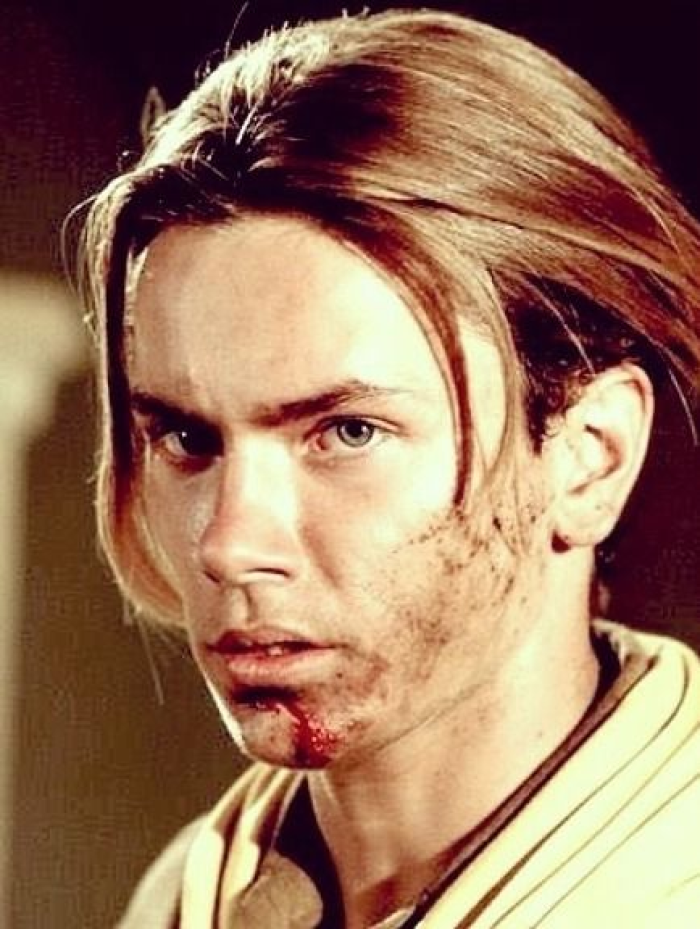
Indy’s adventure comes to a bitter end at home, where his father shows general disinterest in his son’s story. Things get even worse when Indy learns the Sherriff has sided with Panama Hat, forcing him to give up the Cross. Indy is clearly disgusted, and the Fedora Man seems to feel some sympathy, even admiration for him. After losing the Cross, the Fedora Man gifts Indy with the hat that becomes his trademark. Not only that, this failure transforms the idealistic boy scout into a jaded cynic who remakes himself in the Fedora Man’s image, not only adopting his costume but also his mercenary mindset. It’s a choice that sets him off on an adventure lasting over twenty years.
Becoming the Fedora Man
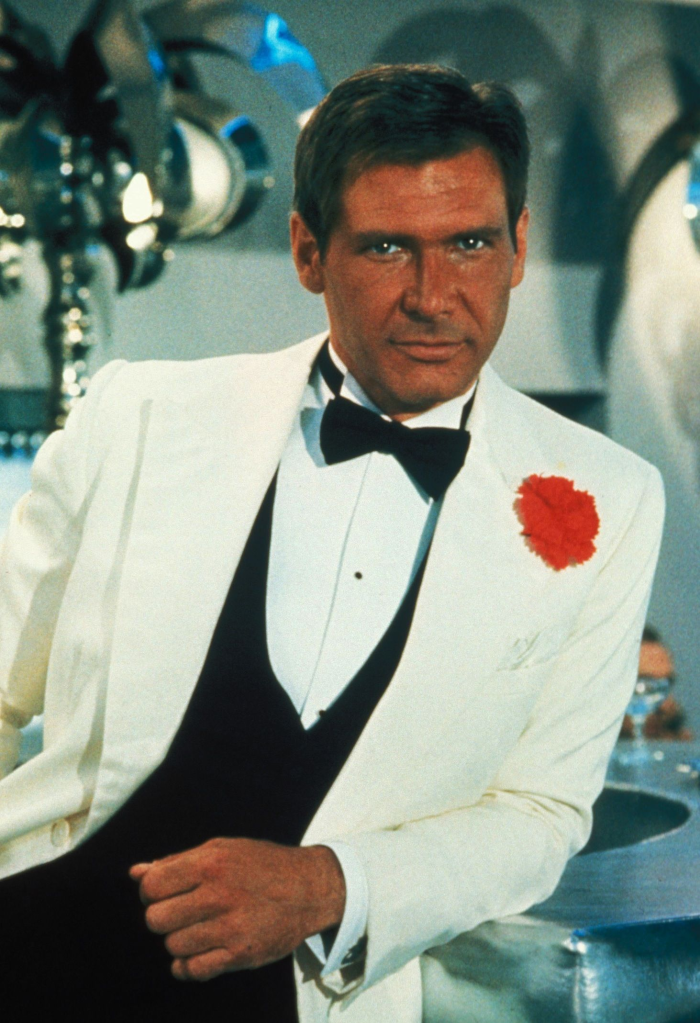
Jumping from this sequence into Temple, we witness firsthand how that idealistic boy scout has fallen from grace. In this scene, which serves as a takeoff on classic Bond films Jones is working for Lao Che, a wealthy collector who hired him to retrieve the remains of Nurhaci, a long-dead emperor. Indy hands over the artifact in exchange for a large diamond promised to him. Here we see how much Indy has remade himself into the Fedora Man, willingly working for a corrupt collector for his own personal gain.

But Indy has done far worse as well. He openly threatens to kill nightclub singer Willie Scott for his payment, and exploits a young orphan named Wan Li, better known as Short Round, for his own benefit. The main quest in this film concerns three enchanted rocks, the Sankara Stones spoken of in Hinduism. It’s a quest that Indy doesn’t seek out, instead winding up in the famine-stricken village after a run of treachery and bad luck.

The villagers tell Indy their ceremonial stone was taken from them along with the village children. Indy’s selfishness comes through strongly in these scenes. Shows of sympathy for the villagers are infrequent and outright quashed by his desire for the stones. This is shown best in a scene where an escaped child finds his way back to the village, giving Indy an old script that supports the story. Indy almost immediately forgets the victim in his lust for the artifact. ‘Fortune and glory’ is an oft-quoted line, but that this is where Indy’s head is at following this encounter with the child really shows how broken that first adventure left him.
Corruption and Purification

The group sets off for the stones, eventually tracing them to the titular Temple of Doom. It’s here Indy’s transformation After witnessing a brutal human sacrifice, Indy retrieves the Sankara Stones and is basically free and clear to escape. Before the group can escape though, Indy hears a noise. Though he hesitates, Indy investigates and finds the village children being exploited for brutal slave labor. In the character’s first show of humanity, Indy attacks one of the guards, leading to the group’s capture.

The villain of the film, Mola Ram, serves a similar purpose in the story to the Fedora Man. He too is an agent of corruption who forcibly models Indy after himself by placing him under a spell. This is Indy pushed to an even greater extreme. It’s interesting to note that Indy isn’t saved from this by his own ingenuity. As Willie Scott saved him earlier from a nasty booby trap, it’s Short Round, a symbol of innocence, who breaks him from his trance. Despite Indy exploiting him, Short Round calls Indy his friend and risks his own life to free him. Touched by the gesture, Indiana Jones apologizes to Short Round, and despite getting the stones once again, opts to risk his life and free the captive children. This is the first time since the opening of the story where Jones makes a conscious choice to do the right thing.
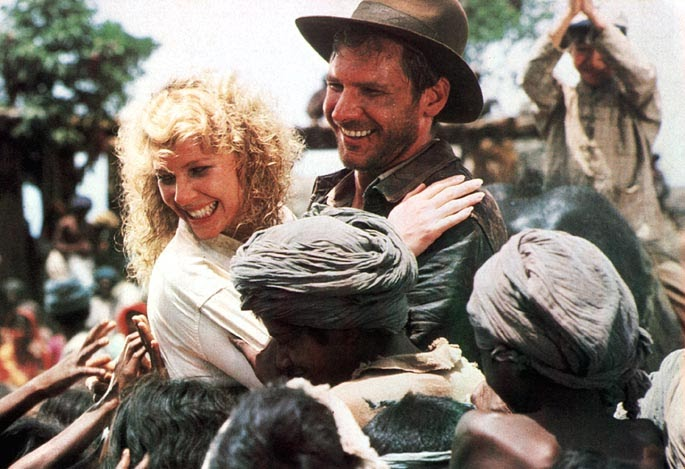
After a series of action set pieces, Indy has his final confrontation with Mola Ram on a rope bridge. While it may seem another set piece on the surface, it features an important moment in Indy’s life. Indy doesn’t vanquish the villain himself. Rather, the Sankara Stones save him, unleashing their power and sending the cultist falling to his death. Humbled by the experience, Indy doesn’t claim the artifact for himself, instead returning it to the villagers along with their captive children. Temple is an important chapter in Indy’s journey, taking him to the furthest depths of corruption before showing his first step back to the boy scout he once was.
Indy Faces His Past
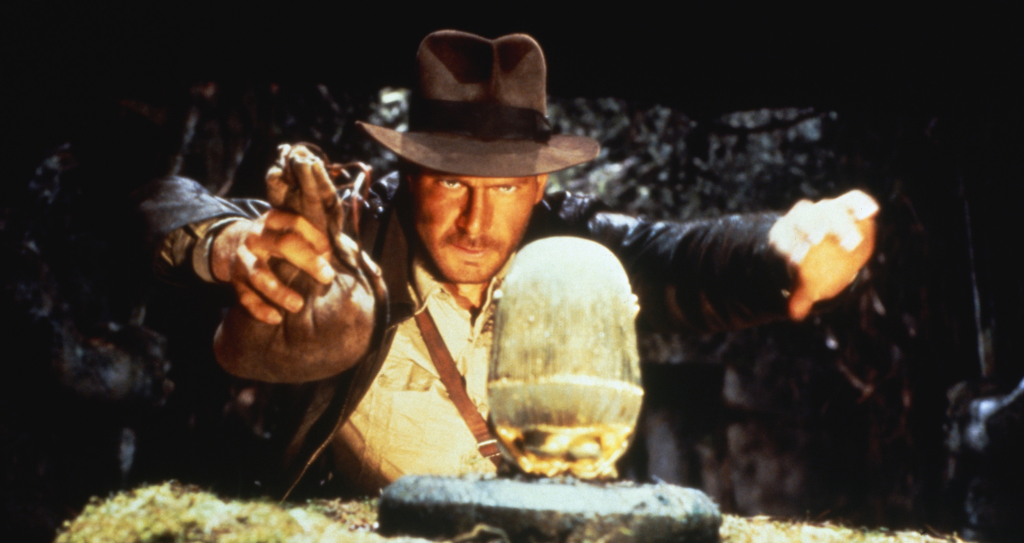
Moving onto Raiders, the central focus of the story is Indiana Jones confronting his past, both the person he once was, and the people he hurt along the way. The film opens with a reformed Indy. Far from the mercenary he used to be, Indy is no longer a gun for hire. Now he focuses on acquiring artifacts for museums, just like in the opening prologue.

Unlike in Temple, Indiana Jones accepts the quest at the start of the story. That quest is to find the Ark of the Covenant. Unlike the mercenary in Temple, Indy is openly enthusiastic about retrieving this important artifact for preservation, but there’s a catch. It forces him to reunite with Marion Ravenwood. Marion and Indy had an affair which resulted in Indy falling out with Marion’s father and his own mentor. It’s hinted that their affair occurred while he was a professor or assistant professor, ranking this high on Indy’s list of wrongdoings. Marion is a victim of Jones and forces him to confront his checkered past. Another such character is his nemesis, rival archeologist René Belloq. Belloq is like Indy was in Temple, willing to work with whoever he needs to get what he wants. In this case, he seeks the Ark as part of a warped spiritual journey and cares little for who is sacrificed along the way.

Indy’s lowest point is when Marion is apparently killed following an abduction staged by Belloq. Feeling responsible for her death and remorse for his past treatment of her, Indy confronts Belloq. Here Belloq taunts Indy with their similarities. Indy doesn’t want to face this, yet we see similarities in the characters with how they treat Marion. When he discovers Marion is alive, Indy leaves her captive in favor of getting the Ark, while Belloq, much like the sleazier Jones of the past, takes a liking to Marion and attempts to seduce her.
Indy’s Reconciliation
Indy manages to sort his priorities out after retrieving the Ark and heading for home with Marion. One of the film’s more comical scenes is also one of the more important. In the scene. Marion tries to help Indy with his injuries and ends up playfully kissing his wounds. Before it can go any further, an exhausted Dr. Jones falls asleep. This is a far cry from the predatory professor we met in Temple. He doesn’t seduce Marion, but treats her instead as a partner. By the end of the film, it’s not the Ark he’s after, but Marion herself. She’s later abducted by the sleazy Belloq, causing Indy to pursue them to a deserted island. Rather than an object of conquest, she represents a second chance for him. A second chance he nearly blows.
As before, Indy is unable to resist the temptation of the Ark. In an unintentional reverse of the opening to Temple, he instead threatens to destroy the artifact unless Marion is released. However, Belloq is able to recognize Indiana’s own lust for treasure is still a part of him, and calls his bluff. Indy is unable to destroy the Ark, and is captured along with Marion.

It’s interesting to note that in Raiders, Indy dismisses the supernatural, despite having seen evidence of it in Temple. While it could be read as a continuity error, it could also be read as denial. While the story wasn’t pre-planned this way, Indy’s initial denial of the supernatural, despite having caught a glimpse of it before, in some ways strengthens his character. At the end of Raiders, he sees unambiguous proof of higher powers, and once more, it’s those powers that save him. The Ark destroys Belloq and his Nazi cohorts, destroying Indy’s shadow while he and Marion are spared.
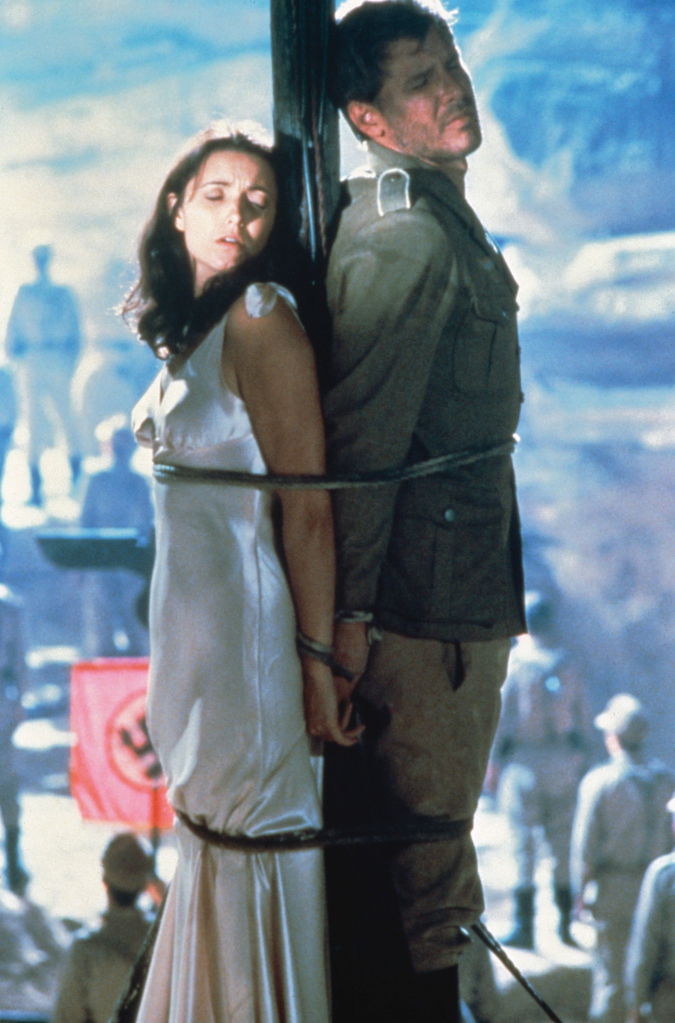
The irony of the ending is while Belloq was on a warped spiritual quest, it’s Indy who achieves enlightenment. He doesn’t get the Ark, something that greatly upsets him. Despite this, he and Marion are once more on good terms. The pair don’t become a couple in this film, instead leaving the adventure as friends. The Ark rids Indy of his shadow, giving him a second chance. This second chance leads to Indy’s final adventure, which proves the most transformative of them all.
The Boy Scout Returns
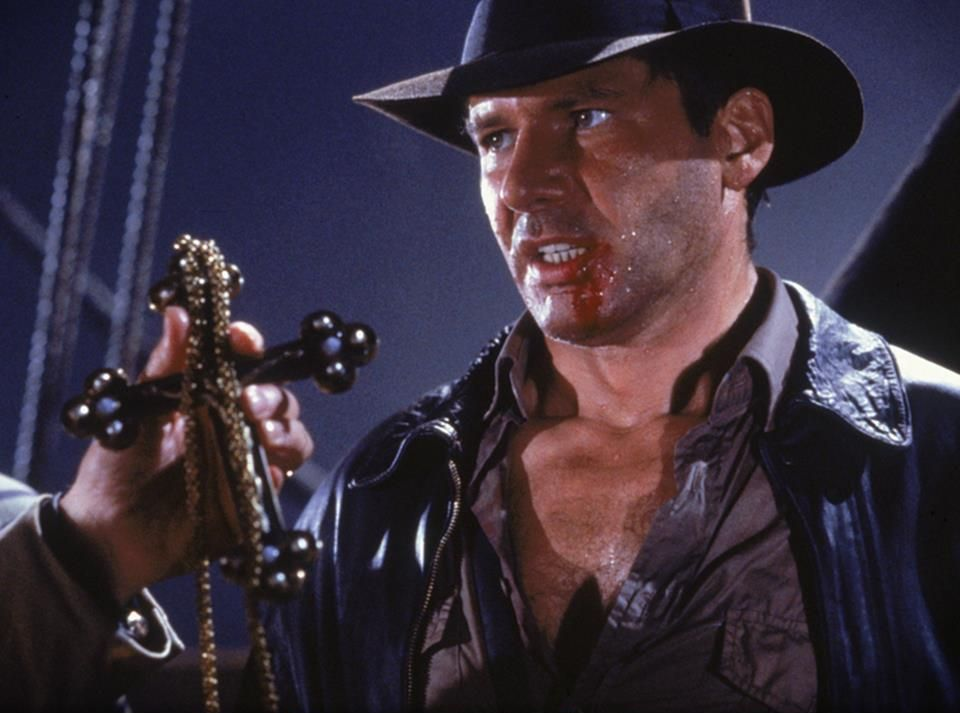
After this long journey of brutal trials and self-reflection, we finally return to the events of Crusade. It’s here that Indiana Jones concludes the quest that started it all, saving the Cross of Coronado from Panama Hat. Though brief, this is one of the saga’s most crucial sequences. Indiana Jones confronts Panama Hat and retrieves the Cross of Coronado. He escapes Panama Hat’s private ship before it explodes, killing his first enemy and allowing Indy to share the Cross with the world, just as he tried to do as an idealistic teenager.
The importance of this artifact to Indy’s character can’t be understated. The loss of this artifact is what destroyed a young boy scout’s ideals and turned him into a cynical soldier of fortune who prayed on those around him. In regaining it, Indiana Jones has regained the symbol of those ideals. Proof of this lies in the Cross’s destination, with Indy. The Stone goes back to the villagers, the Ark is taken by the government, Nurhaci Indy gives up to a criminal, and the diamond he loses in a scuffle. The Cross of Coronado is the only treasure in the series that Indy keeps, having reclaimed the idealistic part of himself taken by Panama Hat and Fedora Man. This is Indy’s full transformation back into the boy scout from before, further reflected by his actions over the rest of the adventure.

The main quest is brought to Jones by Donavan, a wealthy collector who bears an uncomfortable resemblance to Panama Hat. More on that later. Now the quest he’s called upon is for the Holy Grail itself. Not only is the Grail subject of countless tales and legends, but the Grail is the artifact that his father was obsessed over, driving the rift between them. Despite the significance of the artifact, Indy initially refuses to go after it, in sharp contrast to the character in Temple and even Raiders. It’s only after Indy learns his father may be in danger that he decides to follow his trail. In retrieving the Cross, Indy only reconciled the first half of that opening teaser. His father is the second half. At the end of the opening teaser, Indy attempted to reach out to his father. It’s a similar gesture that begins his quest in Crusade.
The Father and the Shadows
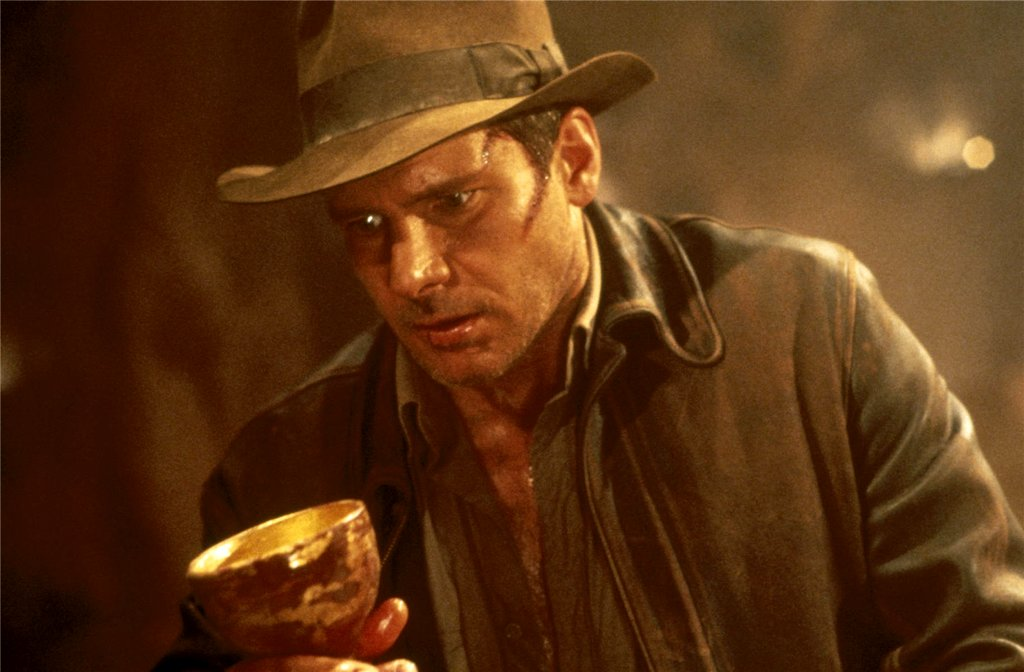
Indiana Jones faces two adversaries in Crusade. The first as it turns out is Donavan, Indy’s own employer. Donavan is much like Panama Hat in that he hires others to plunder riches for him. It’s the first time since the opening that Indy’s enemy is not a foreign army or a wicked cult. Donavan is an American capitalist, and the ultimate lesson is that Indy’s often not working for the good guys. Donavan, like Panama Hat, is an enemy in Indy’s backyard. But Jones finally shows that he’s different than the Fedora Man. While the Fedora Man worked for whoever offered enough, Jones takes a moral stand and sets out to stop his employer from getting the Grail.
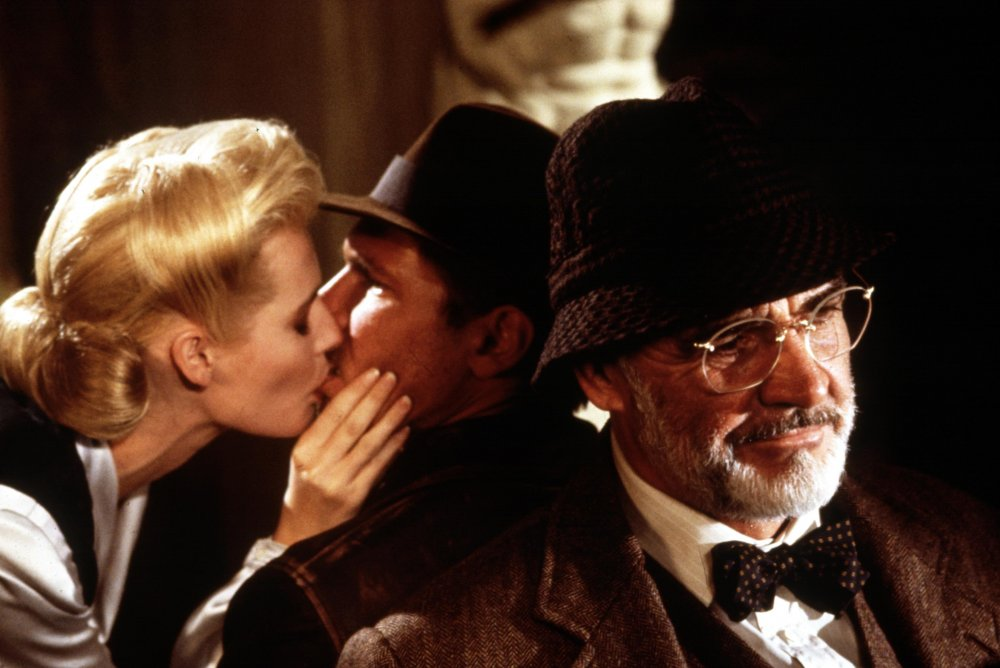
The other enemy in the film is, like Belloq, a shadow of his former self. This time it comes in the form of Elsa Schneider, an Austrian scholar who aligns herself with the Nazis in order to find the Grail. In many ways, Schneider is one of the series’ most despicable people. She doesn’t agree with Nazism as shown during a book burning, which makes her willingness to look the other way that much worse. She’s also an agent of deception and corruption, using Indy and his father both to get what she wants. She has the same attitude Indy did before, and that she’s the only person in the original trilogy Indy sleeps with on camera shows his old life still holds a certain appeal to him.

The person he has the most problematic relationship with is his father Henry Jones Sr., who pulls Indy along on a quest to find the Grail. Indy’s father is important not as a sidekick but as a symbol much like the Cross of Coronado. He’s the other half of the puzzle that was left unsolved by the opening adventure. In a real sense, this is Indy’s final crusade rather than the Grail itself, and we, like Henry, are along for the ride. The movie is just as much from Henry’s perspective as it is Indiana’s, one of the reasons it doesn’t feel quite like the other two films until close to the ending.
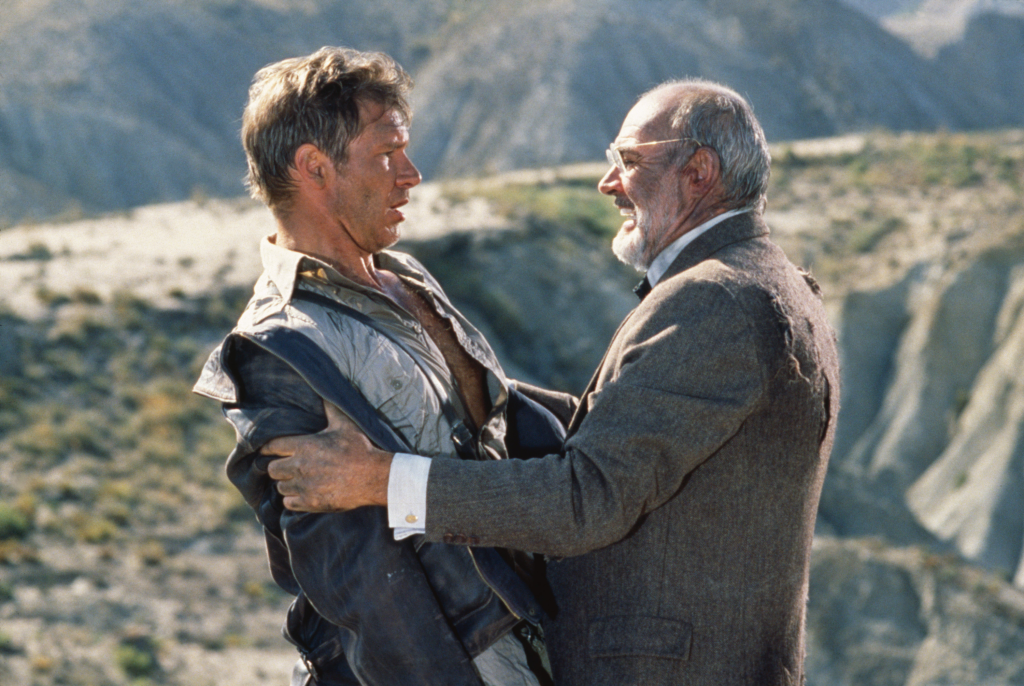
Much of Crusade’s action is set not in jungles, ancient temples, or excavated ruins, but in modern cities, backroads, and even airplanes, the sorts of things Henry Sr. is familiar with. Even Indy’s costume takes a while to fully form. He starts off wearing a suit and tie, and even when he dons the jacket and fedora, that tie is on him for much of the film, leaving the costume feeling slightly off. Henry, along with us, watches Indy transform into the man he’s become, culminating in the tank fight which finally feels like a classic Indiana Jones set piece and is also my personal favorite action scene in the series. This culminates when Henry Sr. believes Indy has been killed. He professes his love for his son and regrets that they were never closer. When he learns Indy is alive, the two share their first genuinely emotional moment before Henry suppresses his emotions again. This paves the way for Indy’s final test.
Indy’s Final Test
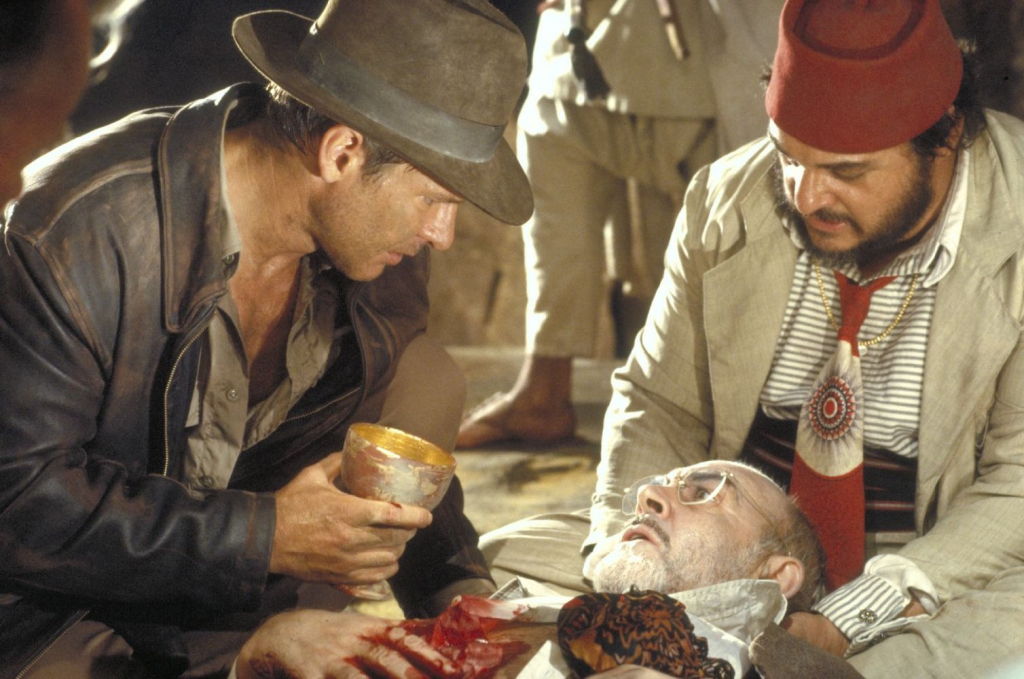
Indy’s final test takes place in a temple in the Canyon of the Crescent Moon, the most exotic location of the movie. We’re finally back into the colorful settings that are a series staple. Here, Donavan fatally shoots Henry to blackmail Indy into retrieving the Grail. With that as his only way to save his father, Indy overcomes a series of boobytraps as deadly as they are symbolic. Indy must be penitent and humble, walk in the footsteps of God, and take a final leap of faith to reach the Grail, which he finds guarded by a knight of the first crusade.
Once more, the artifact kills the main villain, with Elsa knowingly handing Donavan a false Grail. The wealth-obsessed Donavan is fooled by the gem-encrusted gold fake, drinking from it and dying as a result. Indy and Elsa know the real grail wouldn’t be made out of gold, given Jesus’ modest life as a carpenter. The Grail turns out to be an unremarkable clay chalice, which Indy brings to his father to heal his wounds. Elsa, overcome with greed, attempts to steal the Grail from the temple, causing it to collapse. Indy tries to save Elsa after she and the grail fall into a fissure, but Elsa is too much like Indy used to be. She loses all sight of everything around her, holding Indy with one hand, her own chance at redemption, and reaching for the Grail with the other. Indy loses his grip, and Elsa slips and falls to her death, in the process pulling Indy into the same position as her.

In this moment, Indy becomes like he was, like Elsa, like Belloq, and the Fedora Man. He reaches out for the Grail, losing sight of all else. It’s not until his father acknowledges him, referring to him by name for the first time in the film, that he snaps out of it. Here, Henry finally reaches out to him, unambiguously saying he matters more to him than even the Grail. Indy responds to the gesture, and the coldness of their relationship in the opening is gone. The two depart the temple, having finally found themselves, and each other. It’s here that Indy’s main quest comes to an end, reclaiming his lost ideals, and finally achieving the emotional connection he sought since it all began.
A Boy Changed and a Man Healed

To me, these first three movies are the core of the series, a self-contained saga that tells of one man’s emotional journey. All the action and creative set pieces are the icing on the cake. Indiana Jones is a series about how when we grow up, we often lose the things that make us special when we’re young. Indy loses that part of himself and grows into a bitter mercenary before setting off on a journey of self-reflection that allows him to re-discover who he used to be and start life anew. For many of us, including me, it’s a deep hope we all share. When Indiana asks his father what he found on this adventure, Henry says ‘illumination.’
So did I.
[Sources: Medium, Channel Awesome]
Like this article? Check out these similar pieces by some of our top contributors!

4 thoughts on “The Lost Boy Scout – The Journey of Indiana Jones – ScreenHub Entertainment”